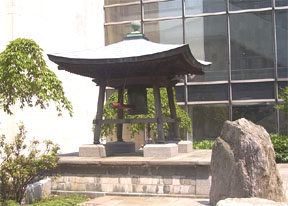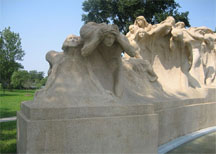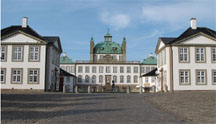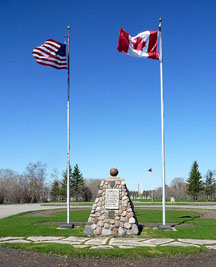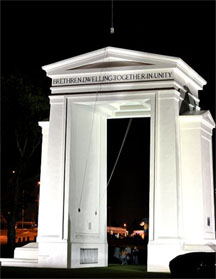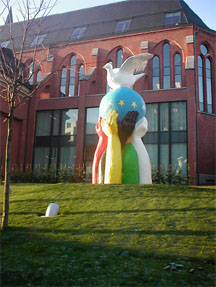The Global Open University
for World Peace (TGOUWP)
Philosophy and Origins
The International Association of Educators for World Peace (IAEWP) under its objectives for giving birth to a university with a view to bringing peace on earth in the third millennium decided to establish "The Global Open University for World Peace" by authorizing the then National Chancellor of IAEWP for Italy, His Holiness TYS Lama Gangchen Tulku Rinpoche and making him the Founder President of this University and issuing a notification on 5th June 1998 issued by the IAEWP Founder Dr. Charles Mercieca and the then IAEWP President Dr. Surya Nath Prasad.
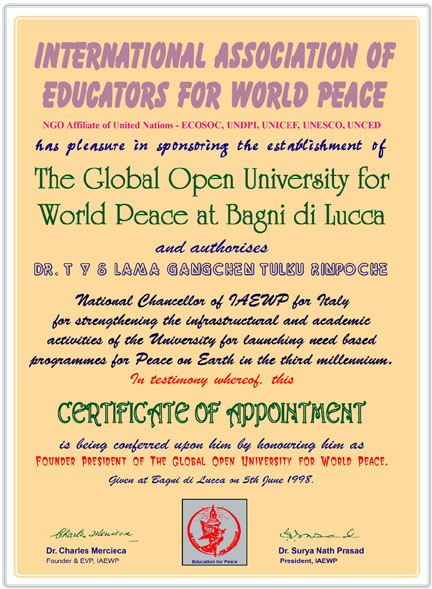
Accordingly The Global Open University for World Peace (TGOUWP) was established and launched jointly by Dr. Charles Mercieca and H.H. Lama Gangchen on 5th June 1988 at Bagni di Lucca, Italy in the presence of thousands of peace educators.
Because peaceful behavior can result from calm or happy emotional states, people are sometimes understood to "feel peaceful." De-escalating conflicts therefore can involve reducing or improving emotions through compliments and generosity. Small gestures of generosity that are reciprocated are sometimes followed with even more gestures. Benevolent generosity can eventually become a pattern that is a lasting basis for improved relations. Peace talks often start without preconditions and preconceived notions because they are more than just negotiating opportunities. They place attention on peace in a way that itself is influential. Peace talks are sometimes also uniquely important learning opportunities.
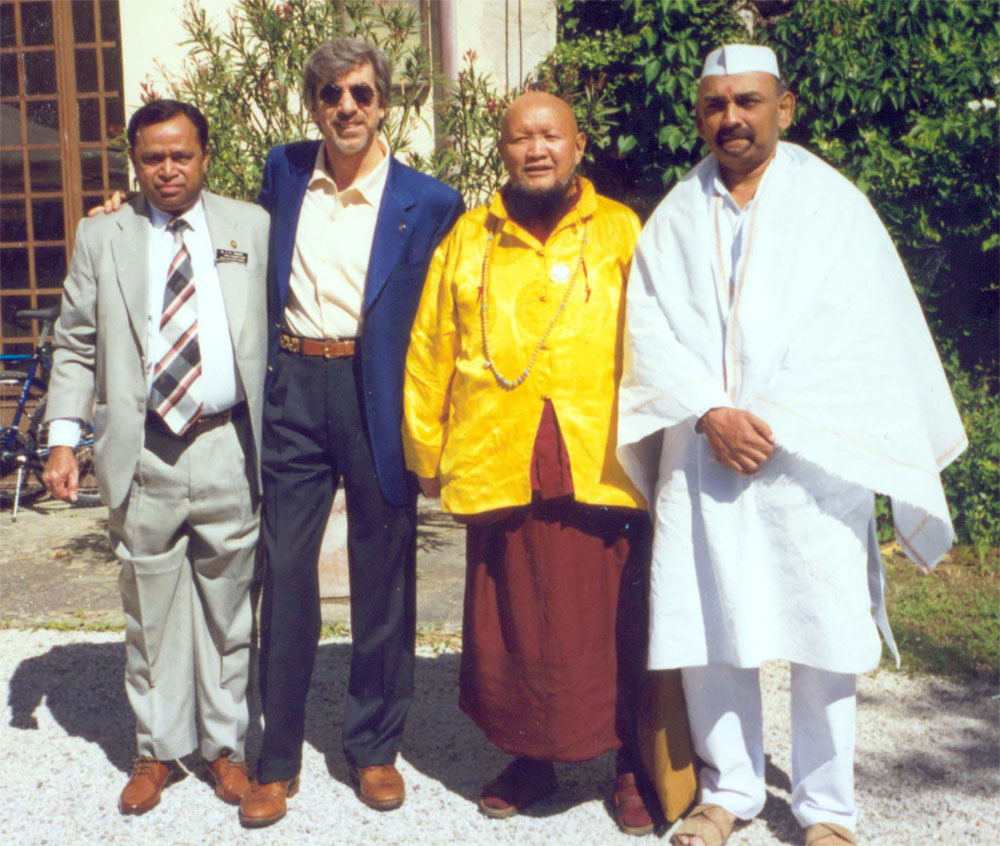
His Holiness TYS Lama Gangchen Tulku Rinpoche, Founder
President of The Global Open University for World Peace (TGOUWP)
with IAEWP
President Dr. Surya Nath Prasad, famous Actor Mr. Marco
Columbro and IAEWP Vice President for South Asia Dr. P
R Trivedi during the
inauguration of TGOUWP on 5th June 1988 at Bagni
di Lucca, Italy.
The Global Open University for World Peace (TGOUWP) will be observing its 20th Anniversary on 5th June 2018 by organizing different types of interaction meetings all over the world for diagnosing the reasons of peacelessness in different parts of the world. The idea is also to solve not only the problems related to peacelessness but to also solve the related problems like unemployment, poverty, greed, pollution, insurgency, faulty educational system and population explosion.
The Global Open University for World Peace (TGOUWP) is also continuously researching on different aspects of peace with a view to introducing peace education in all the schools, colleges and universities.
According to TGOUWP, Peace is a lack of conflict and freedom from fear of violence between heterogeneous social groups. Benevolent leaders throughout history have shown restraint establishing regional peace and economic growth through peace treaties that resulted from de-escalating conflicts and multilateral and bilateral peace talks. Commonly understood as the absence of war or violent hostility, peace often involves compromise, and therefore is initiated with thoughtful active listening and communication to enhance and create genuine mutual understanding.

His Holiness TYS Lama Gangchen Tulku Rinpoche, Founder President
of The Global Open University for World Peace (TGOUWP) with
his Team Members observing different types of flowers after the
inauguration of TGOUWP on 5th June 1988.
The term 'peace' originates most recently from the Anglo-French pes, and the Old French pais, meaning "peace, reconciliation, silence, agreement" (11th century). But, Pes itself comes from the Latin pax, meaning "peace, compact, agreement, treaty of peace, tranquility, absence of hostility, harmony." The English word came into use in various personal greetings from c.1300 as a translation of the Hebrew word shalom, which, according to Jewish theology, comes from a Hebrew verb meaning 'to be complete, whole'. Although 'peace' is the usual translation, however, it is an incomplete one, because 'shalom,' which is also cognate with the Arabic salaam, has multiple other meanings in addition to peace, including justice, good health, safety, well-being, prosperity, equity, security, good fortune, and friendliness. At a personal level, peaceful behaviors are kind, considerate, respectful, just, and tolerant of others' beliefs and behaviors - tending to manifest goodwill.
This latter understanding of peace can also pertain to an individual's introspective sense or concept of her/himself, as in being "at peace" in one's own mind, as found in European references from c.1200. The early English term is also used in the sense of "quiet", reflecting calm, serene, and meditative approaches to family or group relationships that avoid quarreling and seek tranquility - an absence of disturbance or agitation.
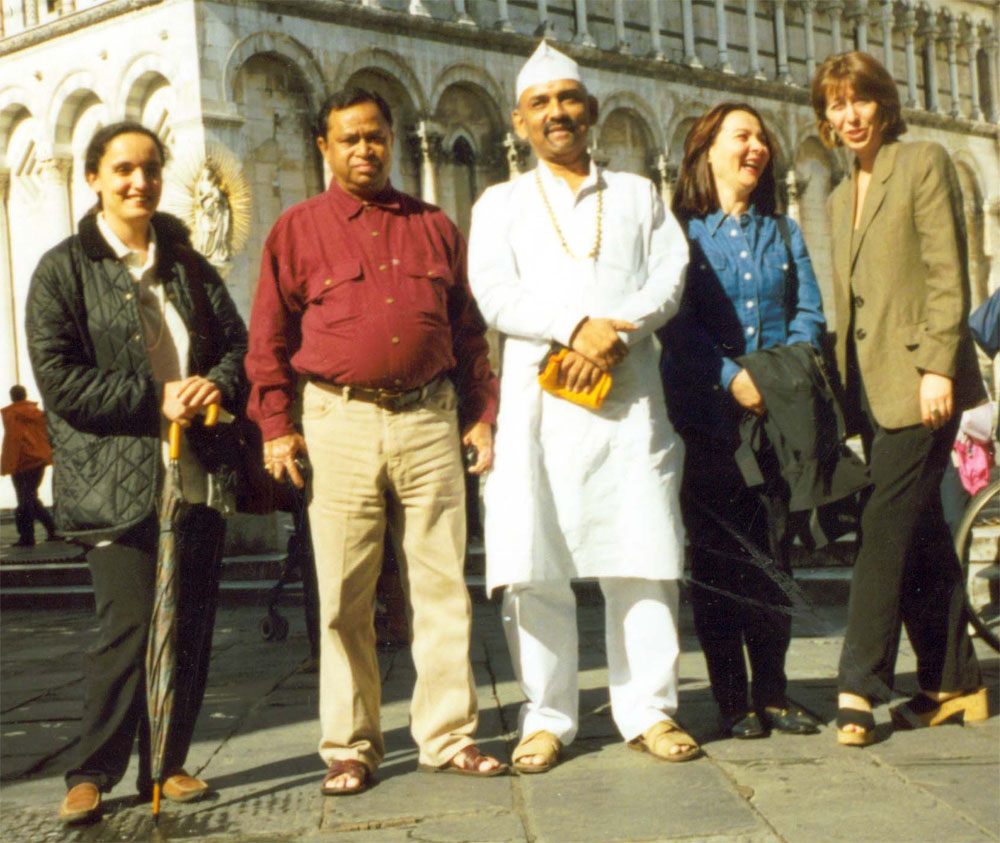
IAEWP President Dr. Surya Nath Prasad and IAEWP Vice President
Dr. P R Trivedi with the office bearers of The Global Open University
for World Peace on 5th June 1988 at Bagni di Lucca, Italy.
In many languages, the word for peace is also used as a greeting or a farewell, for example the Hawaiian word aloha, as well as the Arabic word salaam. In English the word peace is occasionally used as a farewell, especially for the dead, as in the phrase rest in peace.
Wolfgang Dietrich in his research project which led to the book The Palgrave International Handbook of Peace Studies (2011) maps the different meanings of peace in different languages and from different regions across the world. Later, in his Interpretations of Peace in History and Culture (2012), he groups the different meanings of peace into five peace families: Energetic/Harmony, Moral/Justice, Modern/Security, Postmodern/Truth, and Transrational, a synthesis of the positive sides of the four previous families.
Religious beliefs and peace
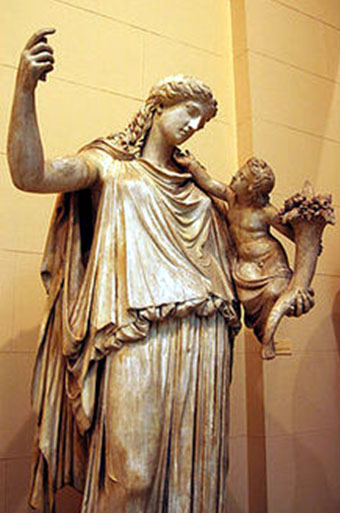
Statue of
Eirene,
goddess of peace in ancient
Greek religion, with her son Pluto.
Religious beliefs often seek to identify and address the basic problems of human life, including the conflicts between, among, and within persons and societies. Among pagan faiths, worship of personified Peace was organized in antiquity under the name Eirene ("Peace") in Greek-speaking areas and as Pax ("Peace") in Latin-speaking ones. Her idols depicted a full-grown woman, usually with a horn of plenty and scepter and sometimes with a torch or olive leaves.
Christians, who believe Jesus of Nazareth to be the Jewish Messiah called Christ (meaning Anointed One), interpret Isaiah 9:6 as a messianic prophecy of Jesus in which he is called the "Prince of Peace." In the Gospel of Luke, Zechariah celebrates his son John: And you, child, will be called prophet of the Most High, for you will go before the Lord to prepare his ways, to give his people knowledge of salvation through the forgiveness of their sins, because of the tender mercy of our God by which the daybreak from on high will visit us to shine on those who sit in darkness and death's shadow, to guide our feet into the path of peace.
Numerous pontifical documents on the Holy Rosary document a continuity of views of the Popes to have confidence in the Holy Rosary as a means to foster peace. Subsequently, to the Encyclical Mense maio,1965, in which he urged the practice of the Holy Rosary, "the prayer so dear to the Virgin and so much recommended by the Supreme Pontiffs," and as reaffirmed in the encyclical Christi Matri, 1966, to implore peace, Pope Paul VI stated in the apostolic Recurrens mensis, October 1969, that the Rosary is a prayer that favors the great gift of peace.
Islam derived from the root word salam which literally means peace. Muslims are called followers of Islam. Quran clearly stated "Those who have believed and whose hearts are assured by the remembrance of Allah. Unquestionably, by the remembrance of Allah, hearts are assured" and stated "O you who have believed, when you are told, "Space yourselves" in assemblies, then make space; Allah will make space for you. And when you are told, "Arise," then arise; Allah will raise those who have believed among you and those who were given knowledge, by degrees. And Allah is Acquainted with what you do."
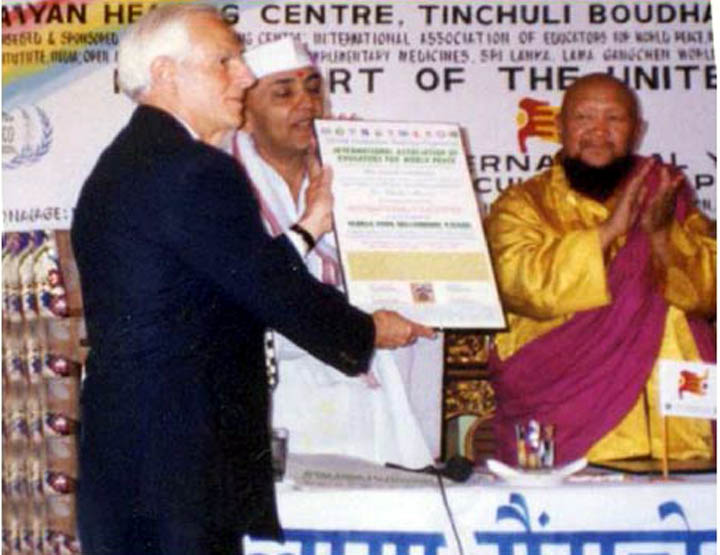
His Holiness TYS Lama Gangchen Tulku Rinpoche, Founder President
of
The Global Open University for World Peace (TGOUWP) being
felicitated by the IAEWP Founder
Dr. Charles Mercieca.
Buddhists believe that peace can be attained once all suffering ends. They regard all suffering as stemming from cravings (in the extreme, greed), aversions (fears), or delusions. To eliminate such suffering and achieve personal peace, followers in the path of the Buddha adhere to a set of teachings called the Four Noble Truths - a central tenet in Buddhist philosophy.
Hindu texts contain the following passages:
May there be peace in the heavens, peace in the atmosphere, peace on the earth. Let there be coolness in the water, healing in the herbs and peace radiating from the trees. Let there be harmony in the planets and in the stars, and perfection in eternal knowledge. May everything in the universe be at peace. Let peace pervade everywhere, at all times. May I experience that peace within my own heart.
--- Yajur Veda 36.17)
Let us not concord with our own people, and concord with people who are strangers to us. Celestial Twins, create between us and the strangers a unity of hearts. May we unite in our minds, unite in our purposes, and not fight against the heavenly spirit within us. Let not the battle-cry rise amidst many slain, nor the arrows of the war-god fall with the break of day
--- Yajur Veda 7.52
A superior being does not render evil for evil. This is a maxim one should observe... One should never harm the wicked or the good or even animals meriting death. A noble soul will exercise compassion even towards those who enjoy injuring others or cruel deeds... Who is without fault?
--- Valmiki, Ramayana
The chariot that leads to victory is of another kind. Valour and fortitude are its wheels; truthfulness and tirtuous conduct are its banner; strength, discretion, self-restraint and benevolence are its four horses, harnessed with the cords of forgiveness, compassion and equanimity... Whoever has this righteous chariot, has no enemy to conquer anywhere.
--- Valmiki, Ramayana
Inner peace
Inner peace (or peace of mind) refers to a state of being mentally and spiritually at peace, with enough knowledge and understanding to keep oneself strong in the face of discord or stress. Being "at peace" is considered by many to be healthy homeostasis and the opposite of being stressed or anxious. Peace of mind is generally associated with bliss and happiness.
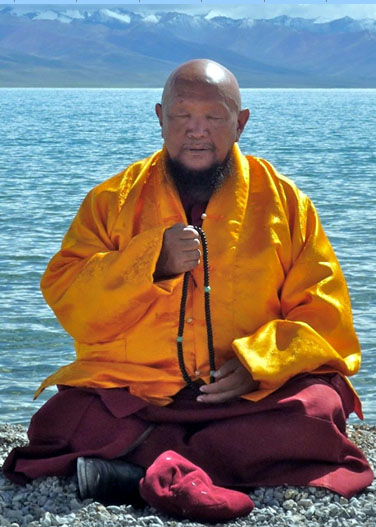
H.H. Lama Gangchen during meditation.
Peace of mind, serenity, and calmness are descriptions of a disposition free from the effects of stress. In some cultures, inner peace is considered a state of consciousness or enlightenment that may be cultivated by various forms of training, such as prayer, meditation or yoga, for example. Many spiritual practices refer to this peace as an experience of knowing oneself. Finding inner peace is often associated with traditions such as Buddhism and Hinduism as well as the New Age movement and Christianity.
Satyagraha
Satyagraha is a philosophy and practice of nonviolent resistance developed by Mohandas Karamchand Gandhi. He deployed satyagraha techniques in campaigns for Indian independence and also during his earlier struggles in South Africa.
The word satyagraha itself was coined through a public contest that Gandhi sponsored through the newspaper he published in South Africa, 'Indian Opinion', when he realized that neither the common, contemporary Hindu language nor the English language contained a word which fully expressed his own meanings and intentions when he talked about his nonviolent approaches to conflict. According to Gandhi's autobiography, the contest winner was Maganlal Gandhi (presumably no relation), who submitted the entry 'sadagraha', which Gandhi then modified to 'satyagraha'. Etymologically, this Hindic word means 'truth-firmness', and is commonly translated as 'steadfastness in the truth' or 'truth-force'.
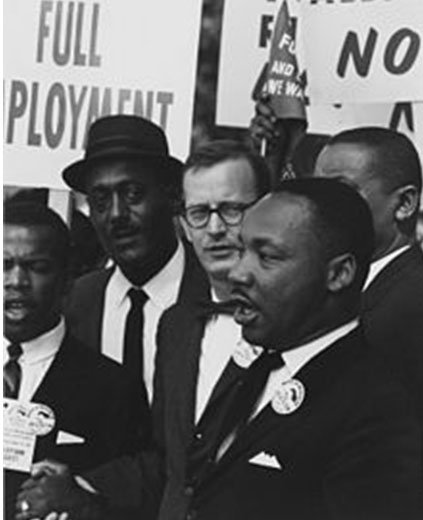
Martin Luther King, Jr., President of the Southern Christian
Leadership Conference, and Mathew Ahmann, Executive Director of the
National Catholic Conference for Interrracial Justice, at a
civil rights march on Washington, D.C.
Satyagraha theory also influenced Martin Luther King Jr. during the campaigns he led during the civil rights movement in the United States. The theory of satyagraha sees means and ends as inseparable. Therefore, it is contradictory to try to use violence to obtain peace. As Gandhi wrote: "They say, 'means are, after all, means'. I would say, 'means are, after all, everything'. As the means so the end..." A contemporary quote sometimes attributed to Gandhi, but also to A. J. Muste, sums it up: 'There is no way to peace; peace is the way.'
Justice and injustice
Since classical times, it has been noted that peace has sometimes been achieved by the victor over the vanquished by the imposition of ruthless measures. In his book Agricola the Roman historian Tacitus includes eloquent and vicious polemics against the rapacity and greed of Rome. One, that Tacitus says is by the Caledonian chieftain Calgacus, ends Auferre trucidare rapere falsis nominibus imperium, atque ubi solitudinem faciunt, pacem appellant. (To ravage, to slaughter, to usurp under false titles, they call empire; and where they make a desert, they call it peace. -- Oxford Revised Translation).
Discussion of peace is therefore at the same time a discussion on the form of such peace. Is it simple absence of mass organized killing (war) or does peace require a particular morality and justice? (just peace). A peace must be seen at least in two forms:
- A simple silence of arms, absence of war.
- Absence of war accompanied by particular requirements for the mutual settlement of relations, which are characterized by terms such as justice, mutual respect, respect for law and good will.
More recently, advocates for radical reform in justice systems have called for a public policy adoption of non-punitive, non-violent Restorative Justice methods, and many of those studying the success of these methods, including a United Nations working group on Restorative Justice, have attempted to re-define justice in terms related to peace. From the late 2000s on, a Theory of Active Peace has been proposed which conceptually integrates justice into a larger peace theory.
Long periods of peace
The longest continuing period of peace among currently existing states is observed in Sweden, which has had peace since 1814 (for 203 years; if Swedish participation in the wars in Afghanistan and Libya is not considered) after its loss of major parts of the country to Russia in the Napoleonic wars. Swedish peace may partly be explained by its geographical position, partly by non-participation in military alliances during peacetime, resulting in a certain level of Swedish neutrality during wartime, and partly by the periods of relative peace in Europe and the world known as Pax Britannica (1815-1914) and Pax Europaea/Pax Americana (since 1950s).
Other examples of long periods of peace are:
- the isolationistic Edo period (also known as Tokugawa shogunate) in Japan 1603 to 1868 (250 years)
- Pax Khazarica in Khazar Khanate (south-east Turkey) about 700-950 AD (250 years)
- Pax Romana in the Roman empire (for 190 or 206 years).
Movements and activism
Pacifism
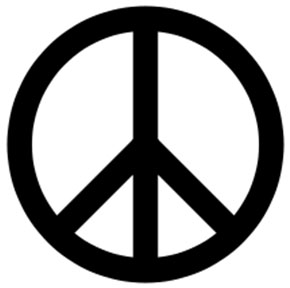
A peace sign, which is widely associated with pacifism
Pacifism is the categorical opposition to any forms of war or violence as means of settling disputes or gaining advantage. Pacifism covers a spectrum of views ranging from the belief that international disputes can and should be peacefully resolved; to calls for the abolition of the institutions of the military and war; to opposition to any organization of society through governmental force (anarchist or libertarian pacifism); to rejection of the use of physical violence to obtain political, economic or social goals; to opposition to violence under any circumstance, including defense of self and others.
Pacifism may be based on moral principles (a deontological view) or pragmatism (a consequentialist view). Principled pacifism holds that violence of any form is an inappropriate response to conflict, and is morally wrong. Pragmatic pacifism holds that the costs of war and inter-personal violence are so substantial that better ways of resolving disputes must be found. Pacifists in general reject theories of Just War.
Organizations
United Nations
The United Nations (UN) is an international organization whose stated aims are to facilitate cooperation in international law, international security, economic development, social progress, human rights, and achieving world peace. The UN was founded in 1945 after World War II to replace the League of Nations, to stop wars between countries, and to provide a platform for dialogue.
The UN, after approval by the Security Council, sends peacekeepers to regions where armed conflict has recently ceased or paused to enforce the terms of peace agreements and to discourage combatants from resuming hostilities. Since the UN does not maintain its own military, peacekeeping forces are voluntarily provided by member states of the UN. The forces, also called the "Blue Helmets", who enforce UN accords are awarded United Nations Medals, which are considered international decorations instead of military decorations. The peacekeeping force as a whole received the Nobel Peace Prize in 1988.
League of Nations
The principal forerunner of the United Nations was the League of Nations. It was created at the Paris Peace Conference of 1919, and emerged from the advocacy of Woodrow Wilson and other idealists during World War I. The Covenant of the League of Nations was included in the Treaty of Versailles in 1919, and the League was based in Geneva until its dissolution as a result of World War II and replacement by the United Nations. The high hopes widely held for the League in the 1920s, for example amongst members of the League of Nations Union, gave way to widespread disillusion in the 1930s as the League struggled to respond to challenges from Nazi Germany, Fascist Italy, and Japan.
One of the most important scholars of the League of Nations was Sir Alfred Zimmern. Like many of the other British enthusiasts for the League, such as Gilbert Murray and Florence Stawell - the so-called "Greece and peace" set - he came to this from the study of the classics.
The creation of the League of Nations, and the hope for informed public opinion on international issues (expressed for example by the Union for Democratic Control during World War I), also saw the creation after World War I of bodies dedicated to understanding international affairs, such as the Council on Foreign Relations in New York and the Royal Institute of International Affairs at Chatham House in London. At the same time, the academic study of international relations started to professionalize, with the creation of the first professorship of international politics, named for Woodrow Wilson, at Aberystwyth, Wales, in 1919.
Olympic Games
The late 19th century idealist advocacy of peace which led to the creation of the Nobel Peace Prize, the Rhodes Scholarships, the Carnegie Endowment for International Peace, and ultimately the League of Nations, also saw the re-emergence of the ancient Olympic ideal. Led by Pierre de Coubertin, this culminated in the holding in 1896 of the first of the modern Olympic Games.
Nobel Peace Prize
The highest honour awarded to peace maker is the Nobel Prize in Peace, awarded since 1901 by the Norwegian Nobel Committee. It is awarded annually to internationally notable persons following the prize's creation in the will of Alfred Nobel. According to Nobel's will, the Peace Prize shall be awarded to the person who "...shall have done the most or the best work for fraternity between nations, for the abolition or reduction of standing armies and for the holding and promotion of peace congresses."
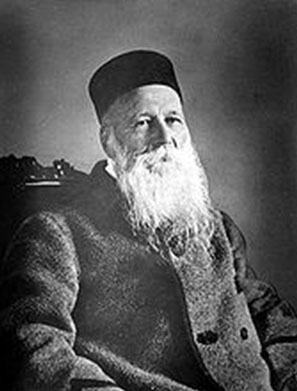
Henry Dunant was
awarded the first-ever Nobel Peace Prize
for his role in founding the International Red Cross.
Rhodes Scholarships and other fellowships
In creating the Rhodes Scholarships for outstanding students from the United States, Germany and much of the British Empire, Cecil Rhodes wrote in 1901 that 'the object is that an understanding between the three great powers will render war impossible and educational relations make the strongest tie'. This peace purpose of the Rhodes Scholarships was very prominent in the first half of the 20th century, and became prominent again in recent years under Warden of the Rhodes House Donald Markwell, a historian of thought about the causes of war and peace. This vision greatly influenced Senator J. William Fulbright in the goal of the Fulbright fellowships to promote international understanding and peace, and has guided many other international fellowship programs, including the Schwarzman Scholars to China created by Stephen A. Schwarzman in 2013.
International Peace Belt
The International Peace Belt, created by artist Wendy Black Nasta, is a living symbol of the peaceful unity of all nations.
Gandhi Peace Prize
The International Gandhi Peace Prize, named after Mahatma Gandhi, is awarded annually by the Government of India. It is launched as a tribute to the ideals espoused by Gandhi in 1995 on the occasion of the 125th anniversary of his birth. This is an annual award given to individuals and institutions for their contributions towards social, economic and political transformation through non-violence and other Gandhian methods.
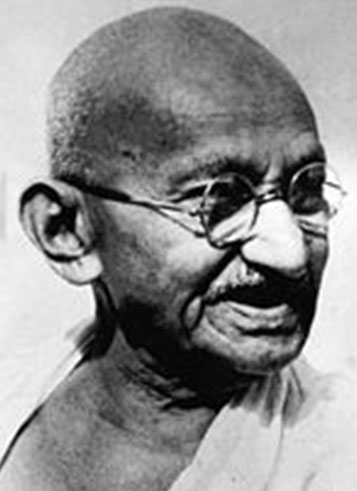
Mahatma Gandhi
The award carries Rs. 10 million in cash, convertible in any currency in the world, a plaque and a citation. It is open to all persons regardless of nationality, race, creed or sex.
Paul Bartlett R Peace Prize
The Paul Bartlett R Peace Prize, named after the artist Paul R, is awarded bi-annually by the University of New Mexico (UNM).
Student Peace Prize
The Student Peace Prize is awarded biennially to a student or a student organization that has made a significant contribution to promoting peace and human rights.
Culture of Peace News Network
The Culture of Peace News Network, otherwise known simply as CPNN, is a UN authorized interactive online news network, committed to supporting the global movement for a culture of peace.
The Sydney Peace Prize
Every year in the first week of November, the
Sydney Peace Foundation presents the Sydney Peace Prize. The
Sydney Peace Prize is awarded to an organization or an
individual whose life and work has demonstrated significant
contributions to:
The achievement of peace with justice locally,
nationally or internationally
The promotion and attainment of human rights. The philosophy, language and practice of non violence
Other
A peace museum is a museum that documents historical peace initiatives. Many peace museums also provide advocacy programs for nonviolent conflict resolution. This may include conflicts at the personal, regional or international level.
Smaller institutions:
- Randolph Bourne Institute
- The McGill Middle East Program of Civil Society and Peace Building
- International Festival of Peace Poetry
Monuments
The following are monuments to peace:
|
Name |
Location |
Organization |
Meaning |
Image |
|
Japanese Peace Bell |
New York City, NY, USA |
United Nations |
World peace |
|
|
Fountain of Time |
Chicago, IL, USA |
Chicago Park District |
100 years of peace between the USA and UK |
|
|
Fredensborg Palace |
Fredensborg, Denmark |
Frederick IV |
The peace between Denmark�Norway and Sweden, after Great Northern War which was signed 3 July 1720 on the site of the unfinished palace. |
|
|
International Peace Garden |
North Dakota, Manitoba |
non-profit organization |
Peace between the US and Canada, World peace |
|
|
Peace Arch |
border between US and Canada, near Surrey, British Columbia. |
non-profit organization |
Built to honour the first 100 years of peace between Great Britain and the United States resulting from the signing of the Treaty of Ghent in 1814. |
|
|
Statue of Europe |
Brussels |
European Commission |
Unity in Peace in Europe |
|
|
Waterton-Glacier International Peace Park |
Alberta, Montana |
non-profit organization |
World Peace |
|
|
The Peace Dome |
Windyville, MO, USA |
not-for-profit organization |
Many minds working together toward a common ideal to create real and lasting transformation of consciousness on planet Earth. A place for people to come together to learn how to live peaceably. |
|
|
Shanti Stupa |
Pokhara, Nepal |
Nipponzan-Myōhōji-Daisanga |
One of eighty peace pagodas in the World. |
Theories
Many different theories of "peace" exist in the world of peace studies, which involves the study of de-escalation, conflict transformation, disarmament, and cessation of violence. The definition of "peace" can vary with religion, culture, or subject of study.
One definition is that peace is a state of balance and understanding in yourself and between others, where respect is gained by the acceptance of differences, tolerance persists, conflicts are resolved through dialog, people's rights are respected and their voices are heard, and everyone is at their highest point of serenity without social tension.
Game theory
The Peace War Game is a game theory approach to peace and conflict studies. An iterated game originally played in academic groups and by computer simulation for years to study possible strategies of cooperation and aggression. As peace makers became richer over time, it became clear that making war had greater costs than initially anticipated. The only strategy that acquired wealth more rapidly was a "Genghis Khan", a constant aggressor making war continually to gain resources. This led to the development of the "provokable nice guy" strategy, a peace-maker until attacked, improved upon merely to win by occasional forgiveness even when attacked. Multiple players continue to gain wealth cooperating with each other while bleeding the constant aggressor.
Balance of power theories
The classical "realist" position is that the key to promoting order between states, and so of increasing the chances of peace, is the maintenance of a balance of power between states - a situation where no state is so dominant that it can "lay down the law to the rest". Exponents of this view have included Metternich, Bismarck, Hans Morgenthau, and Henry Kissinger. A related approach - more in the tradition of Hugo Grotius than Thomas Hobbes - was articulated by the so-called "English school of international relations theory" such as Martin Wight in his book Power Politics (1946, 1978) and Hedley Bull in The Anarchical Society (1977).
As the maintenance of a balance of power could in some circumstances require a willingness to go to war, some critics saw the idea of a balance of power as promoting war rather than promoting peace. This was a radical critique of those supporters of the Allied and Associated Powers who justified entry into World War I on the grounds that it was necessary to preserve the balance of power in Europe from a German bid for hegemony.
In the second half of the 20th century, and especially during the cold war, a particular form of balance of power - mutual nuclear deterrence - emerged as a widely held doctrine on the key to peace between the great powers. Critics argued that the development of nuclear stockpiles increased the chances of war rather than peace, and that the "nuclear umbrella" made it "safe" for smaller wars (e.g. the Vietnam war and the Soviet invasion of Czechoslovakia to end the Prague Spring), so making such wars more likely.
Democratic peace theory
The democratic peace theory holds that democracies will never go to war with one another.
Peace, free trade, interdependence, and globalization
It was a central tenet of classical liberalism, for example among English liberal thinkers of the late 19th and early 20th century, that free trade promoted peace. For example, the Cambridge economist John Maynard Keynes (1883-1946) said that he was "brought up" on this idea and held it unquestioned until at least the 1920s. During the economic globalization in the decades leading up to World War I, writers such as Norman Angell argued that the growth of economic interdependence between the great powers made war between them futile and therefore unlikely. He made this argument in 1914.
These ideas have again come to prominence among liberal internationalists during the globalization of the late 20th and early 21st century. These ideas have seen capitalism as consistent with, even conducive to, peace.
Peace, socialism, capitalism, and managed capitalism
Socialist, communist, and left-wing liberal writers of the 19th and 20th centuries (e.g., Lenin, J.A. Hobson, John Strachey) argued that capitalism caused war (e.g. through promoting imperial or other economic rivalries that lead to international conflict). This led some to argue that international socialism was the key to peace.
However, in response to such writers in the 1930s who argued that capitalism caused war, the economist John Maynard Keynes (1883-1946) argued that managed capitalism could promote peace. This involved international coordination of fiscal/monetary policies, an international monetary system that did not pit the interests of countries against each other, and a high degree of freedom of trade. These ideas underlay Keynes's work during World War II that led to the creation of the International Monetary Fund and the World Bank at Bretton Woods in 1944, and later of the General Agreement on Tariffs and Trade (subsequently the World Trade Organization).
Theory of 'active peace'
Borrowing from the teachings of Norwegian theorist Johan Galtung, one of the pioneers of the field of Peace Research, on 'Positive Peace', and on the writings of Maine Quaker Gray Cox, a consortium of theorists, activists, and practitioners in the experimental John Woolman College initiative have arrived at a theory of "active peace". This theory posits in part that peace is part of a triad, which also includes justice and wholeness (or well-being), an interpretation consonant with scriptural scholarly interpretations of the meaning of the early Hebrew word shalom. Furthermore, the consortium have integrated Galtung's teaching of the meanings of the terms peacemaking, peacekeeping, and peacebuilding, to also fit into a triadic and interdependent formulation or structure. Vermont Quaker John V. Wilmerding posits five stages of growth applicable to individuals, communities, and societies, whereby one transcends first the 'surface' awareness that most people have of these kinds of issues, emerging successively into acquiescence, pacifism, passive resistance, active resistance, and finally into active peace, dedicating themselves to peacemaking, peacekeeping, and/or peace building.
Peace, international organization, and international law
One of the most influential theories of peace, especially since Woodrow Wilson led the creation of the League of Nations at the Paris Peace Conference of 1919, is that peace will be advanced if the intentional anarchy of states is replaced through the growth of international law promoted and enforced through international organizations such as the League of Nations, the United Nations, and other functional international organizations. One of the most important early exponents of this view was Sir Alfred Zimmern, for example in his 1936 book The League of Nations and the Rule of Law.
Trans-national solidarity
Many "idealist" thinkers about international relations - e.g. in the traditions of Kant and Karl Marx - have argued that the key to peace is the growth of some form of solidarity between peoples (or classes of people) spanning the lines of cleavage between nations or states that lead to war.
One version of this is the idea of promoting international understanding between nations through the international mobility of students - an idea most powerfully advanced by Cecil Rhodes in the creation of the Rhodes Scholarships, and his successors such as J. William Fulbright.
Another theory is that peace can be developed among countries on the basis of active management of water resources.
Many peaces
Following Wolfgang Dietrich, Wolfgang Stzl and the Innsbruck School of Peace Studies, some peace thinkers have abandoned any single and all-encompassing definition of peace. Rather, they promote the idea of many peaces. They argue that since no singular, correct definition of peace can exist, peace should be perceived as a plurality. This post-modern understanding of peace(s) was based on the philosophy of Jean Francois Lyotard. It served as a fundament for the more recent concept of trans-rational peace(s) and elicitive conflict transformation.
Trans-rational peaces
In 2008 Wolfgang Dietrich enlarged his earlier approach of the many peaces to the so-called five families of peace interpretations: the energetic, moral, modern, post-modern and trans-rational approach. Trans-rationality unites the rational and mechanistic understanding of modern peace in a relational and culture-based manner with spiritual narratives and energetic interpretations. The systemic understanding of trans-rational peaces advocates a client-centred method of conflict transformation, the so-called elicitive approach.
Peace without weapons
The theory of peace without weapons is as old as philosophy and human consciousness. This theory holds that weapons per se are a threat to peace, and a removal of all weapons is the way to everlasting peace.
Peace and conflict studies
Peace and conflict studies is an academic field which identifies and analyses violent and nonviolent behaviors, as well as the structural mechanisms attending violent and non violent social conflicts. This is to better understand the processes leading to a more desirable human condition. One variation, Peace studies (irenology), is an interdisciplinary effort aiming at the prevention, de-escalation, and solution of conflicts. This contrasts with war studies (polemology), directed at the efficient attainment of victory in conflicts. Disciplines involved may include political science, geography, economics, psychology, sociology, international relations, history, anthropology, religious studies, and gender studies, as well as a variety of other disciplines.
Publications
The Global Open University for World Peace (TGOUWP) has also brought out the World Encyclopedia of Peace of Global Security, World Encyclopedia of Disarmament Studies, World Encyclopedia of Criminology and Forensic Sciences, World Encyclopedia of Interfaith Studies, and World Encyclopedia of Environmental Sustainability.
